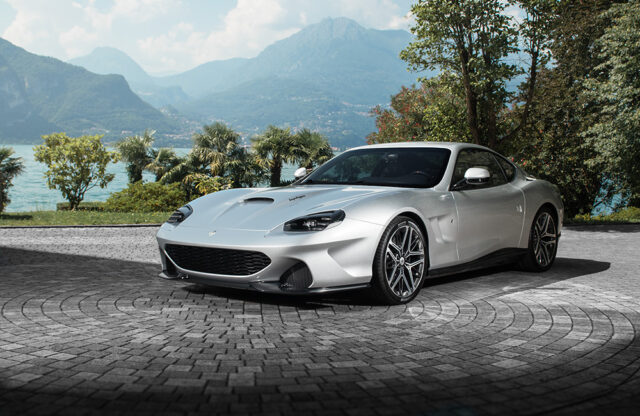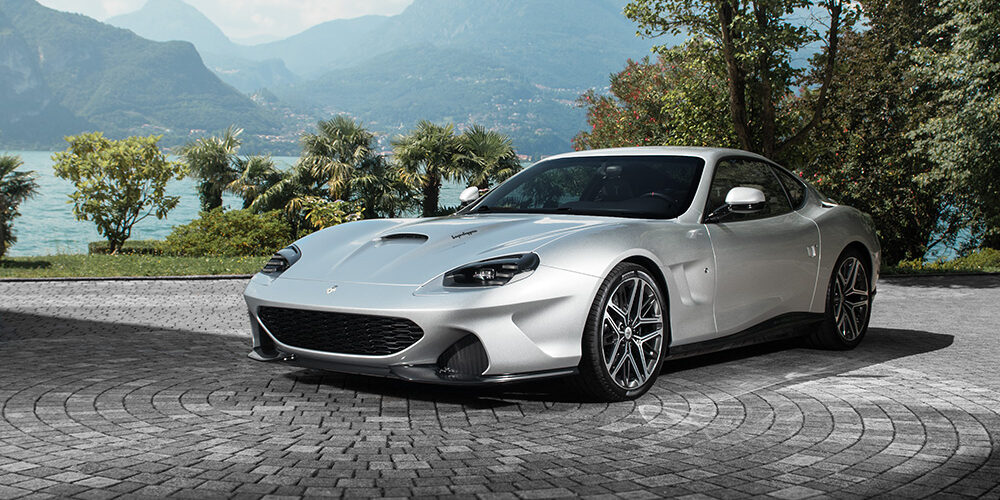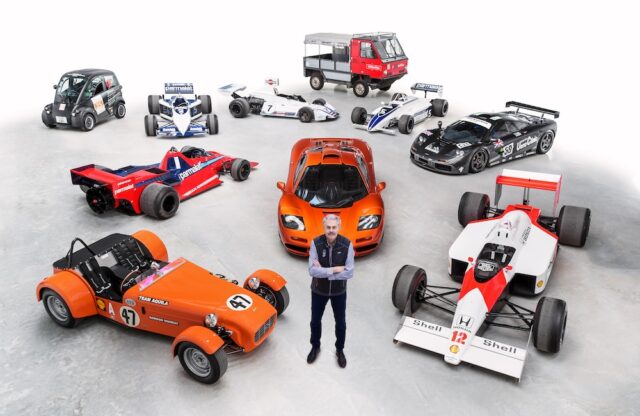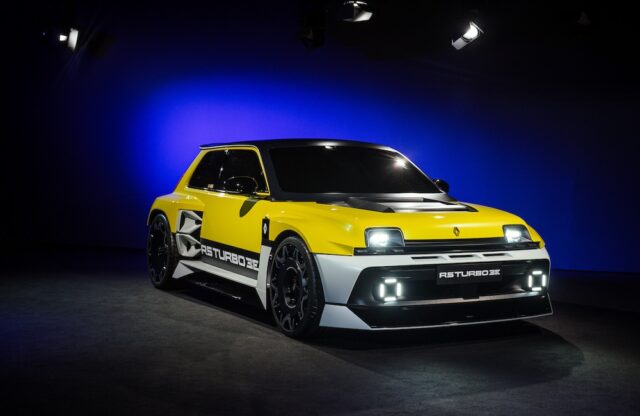Say hello to the Veloce12 – the first new car from Carrozzeria Touring Superleggera since the Arese AH95, and the first full car under its new management team. It also marks the first complete model from Touring’s new design boss, Matteo Gentile.
Magneto spoke at length to Gentile and Touring Superleggera’s CEO Markus Tellenbach about the car and the new direction for Touring Superleggera – but first, just what is the Veloce12?
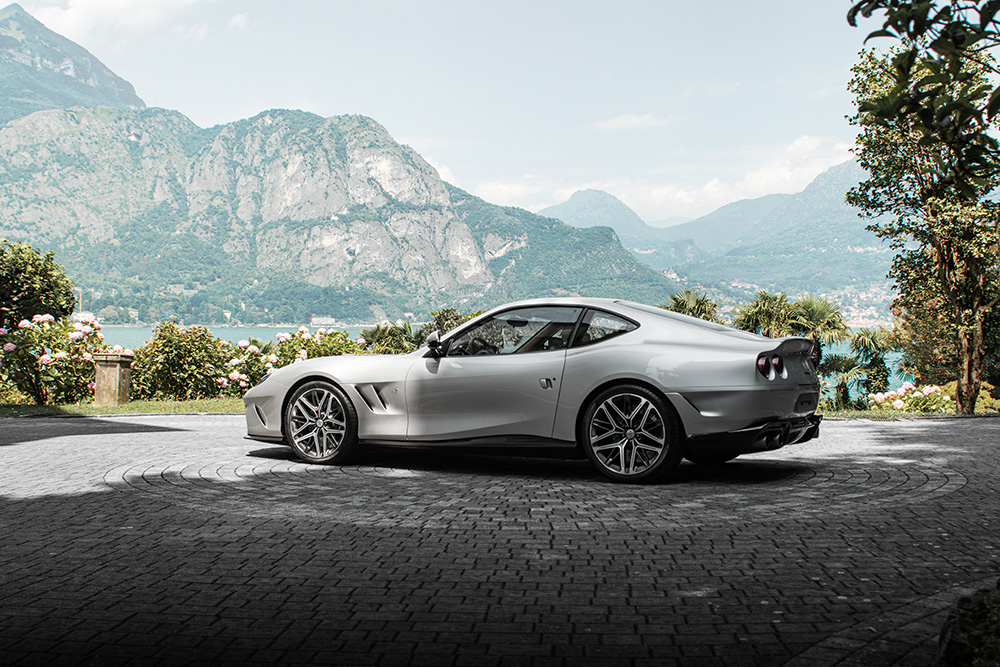
The basis for the Veloce12 is the Ferrari 550 Maranello, now bathed in an entirely new body clothed in weight-saving carbonfibre – Touring says this allowed it design to create a more elaborate and sophisticated design than what was possible in the 1990s, which improves not only aerodynamics but also cooling. The car is much more than a rebody, however.
The chassis has been reinforced with carbonfibre, with the aim of providing contemporary levels of torsional rigidity. For example, Touring cites the 599, which effectively replaced the 550/575, as having 38 percent greater torsional rigidity than its forebear, with the F12berlinetta improving this by a further 20 percent. Touring has undertaken localised stiffening of the door apertures using additional TIG-welded metalwork for extra strength, yet without adding any extra weight.
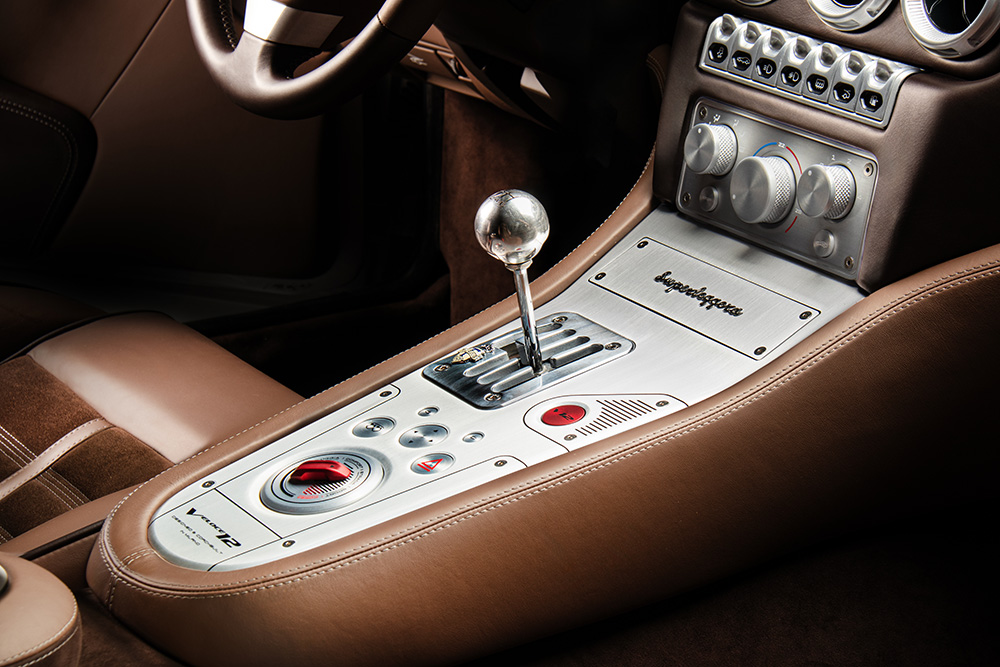
There’s more oomph, too – after giving the donor car’s 5.7-litre V12 an extensive inspection and rebuild, an upgraded cooling system courtesy of PWR and a Supersprint exhaust system liberate an extra 25bhp over the standard car to deliver 503bhp. Touring states a 0-62mph time of 4.4 seconds and a top speed of 199mph. The stopping power has been suitably upgraded, too, with a bespoke set-up designed in association with Brembo to improve pedal feel and reduce unsprung mass. There are 380mm discs front and rear, with six-pot calipers up front and four-pot items at the back.
Perhaps the most critical mechanical transformation comes via the suspension. The 550 previously made do with just two modes: normal and Sport. In collaboration with TracTive, the Veloce12 set-up offers a variety of damping settings for luxurious or sporty driving, using a patented dynamic damping-adjustment valve, controlled by a multi-axes g-sensor. The car rides on bespoke wheels designed by Touring Superleggera, too.
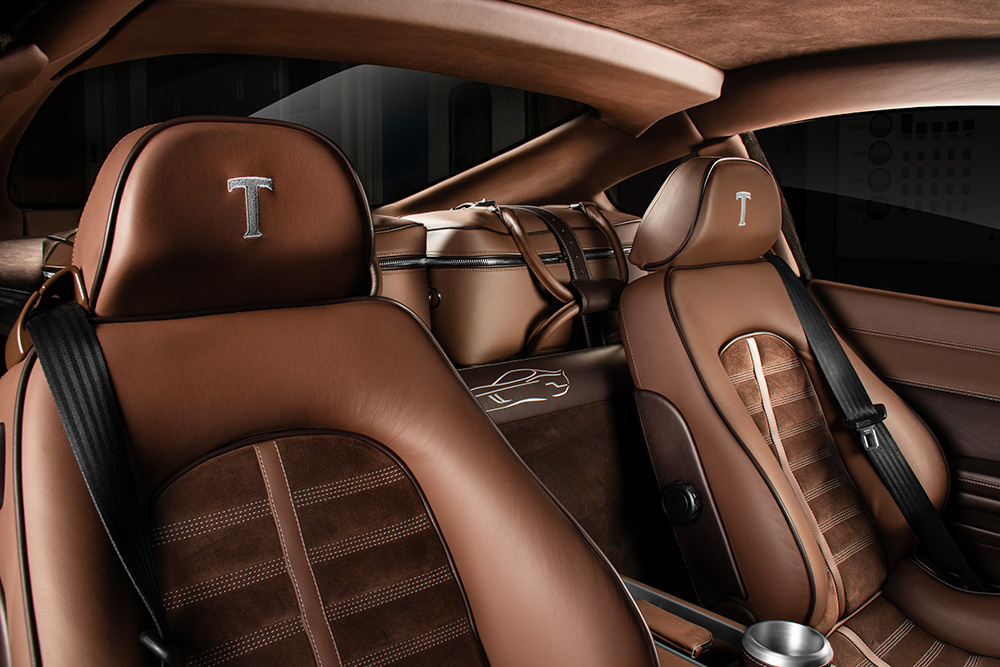
The car’s interior has been given a complete revamp. Although the 550 was universally lauded when new, even if some people weren’t sold on the styling, the interior has come to be a problem as the car has grown older. That’s largely thanks to ageing plastics and soft-touch coatings degrading over time. Touring Superleggera has completely revised the interior, replacing all the surfaces with new materials, such as milled aluminium for the touch points, and leather and Alcantara trim. The car is also available in left- or right-hand drive. Touring promises an almost infinite array of exterior and interior finishes, which can be specified at its Milan HQ or online.
The concept, with Touring CEO Markus Tellenbach
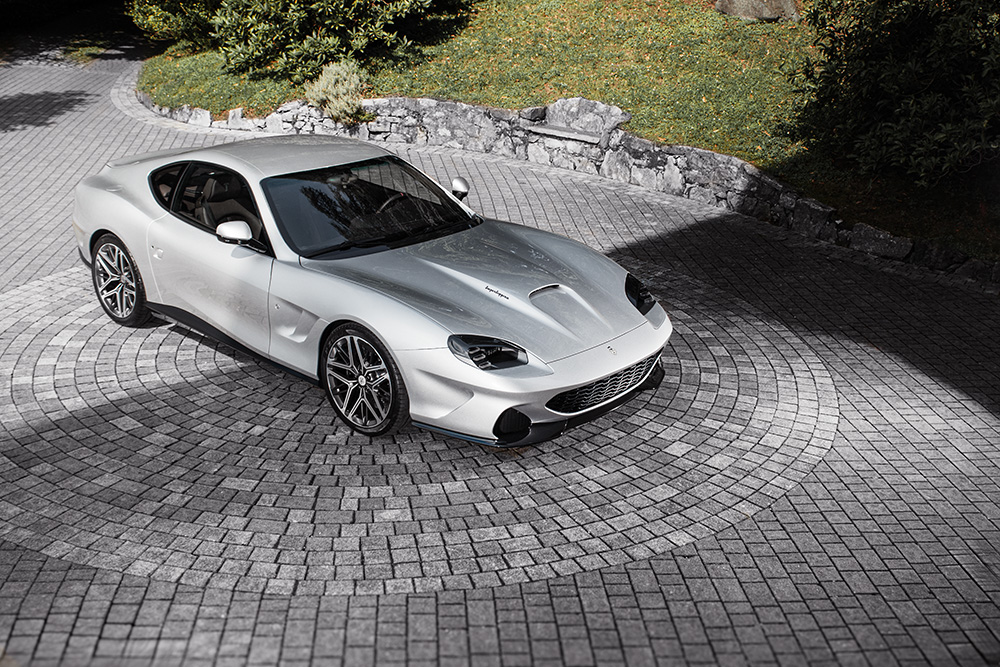
“It was clear that Touring, as a design company, was not going to step into the direction of a simple restomod,” explains Touring Superleggera CEO Markus Tellenbach. “I wanted a car for Quail 2024, and I wanted to touch base in the US market as well. Summing up all that raised the question of needing a unique product, with very good performance at an attractive price.”
The Veloce12’s genes were defined during in-house brainstorming. “We, as Touring, define ourselves as Pure Italianità, and this was the basis in the zero hour of what we wanted to create,” Markus explains. “It became clear it has to be Italian through and through, not just a little bit, or a bit of decoration. It was clear, hidden in the word ‘pure’, that electronics have no space. Pure Italianità was the initial clarity of positioning that extended the technology. That is extended to an Italian donor, and that defines purity as pleasurable and an engaging interaction – and that means a six-speed manual gearbox.”
For Touring, it became clear the 550 Maranello satisfied all the criteria, from design to drivetrain – and the Veloce12’s design is a return to Touring Superleggera’s elegant approach to automotive aesthetics, says Markus. “We are world famous for elegance and beauty, and if I can define elegance in the 1950s and 1960s, it was Touring-designed cars such as the Maserati 3500 and Aston Martin DB5 that set the template for the grand touring car – relatively long nose, quite a distance between A-pillar and front wheel,” he adds. “We believe that this layout allows us to capitalise on what Touring is famous for. Timeless is a big word, but our history is in design that survives, endures and finds its place in history.”
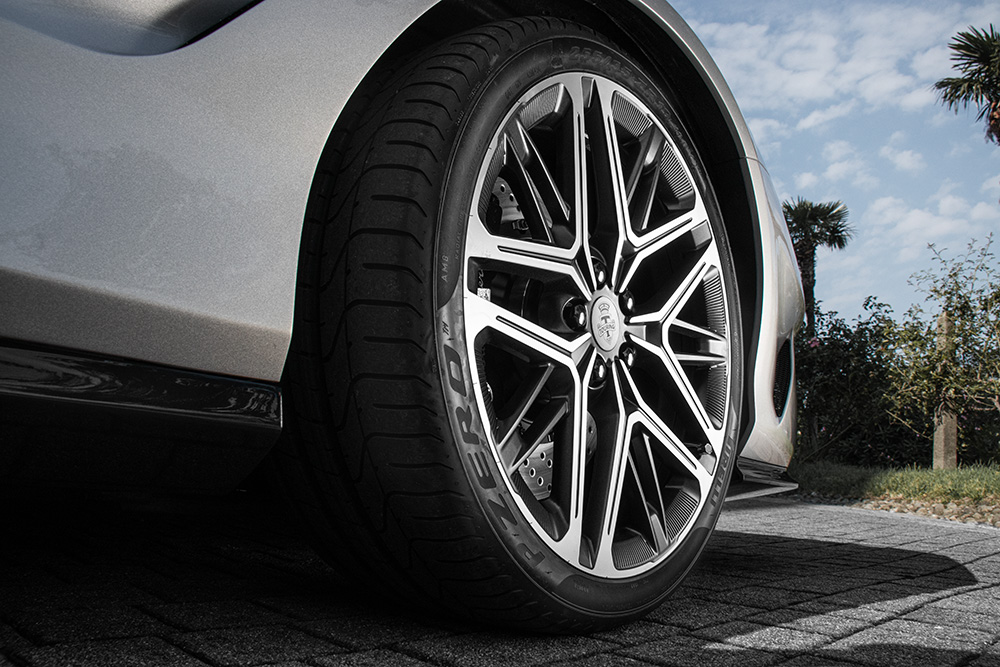
When Magneto last spoke to Markus in late 2023, he admitted that the mid-engined AH95 Arese would not match his refocus on the ‘Gran Turismo’ format as the base for Tourings future design language. “The mid-engined car is not allowing Touring to play all its cards well – we do not stand for lap times, straight-line acceleration and ultimate peaks in performance. That’s not what you expect when you buy a Touring,” he reiterates now. “What you expect is an elegant, powerful and inspiring ‘toy’ that you love and want to use as much as possible; any excuse to take the Veloce12, whether it’s a wine tour, the opera or simply going for a drive.”
Touring’s take on the donor car has gone further than its immediate predecessor – there has been some heavy engineering at play, most notably with the Veloce12’s chassis stiffening and TracTive adaptive suspension. As stated, the donor car has just two suspension modes, normal and Sport. The Veloce12 has a plethora of options, which – given that the donor is lauded as one of the best-drive front-engined Ferraris of all time – might be somewhat controversial.
Markus doesn’t think so: “I bought one and drove it from Milan to Switzerland via the Gotthard pass 20 or 40 times – it’s a brilliant place with the right tool. It became pretty obvious pretty quickly that a chassis from the 1990s lacks what you might expect in terms of confidence-inspiring stiffness, so we decided to tighten the chassis within the framework of homologation. The second part was that the suspension is clearly dated by today’s standard, and that if the driver wanted to drive across Milan’s cobblestone streets, they may want something softer. However, travelling at high speed on a German highway, you would enjoy firmer suspension. That’s why we have an adjustable suspension system with five positions; and at this point in the donor car’s life the suspension would likely need refurbishing anyway.”
Each Veloce12 takes 5000 hours to create, and only 30 are due to be built, with the first cars due to be delivered in early 2025. The price is €690,000 plus the donor car. “This will be an all-in price including customisation, unless something very special is asked for; a visual carbonfibre roof will cost rather more than a painted one, for example,” he explains. “Also, not everybody requires a high-end audio system in such a car, but we can do it.”
For Markus, the car is more in line with what you can expect from Touring in the future. “We do not follow a trend – with this we’re taking a beautiful silhouette and making it contemporary, something we believe is standalone in the industry,” he says. “The initial reaction from those who pre-ordered the car and saw it [at the VIP launch] were very happy.”
Design philosophy, with Touring Head of Design Matteo Gentile
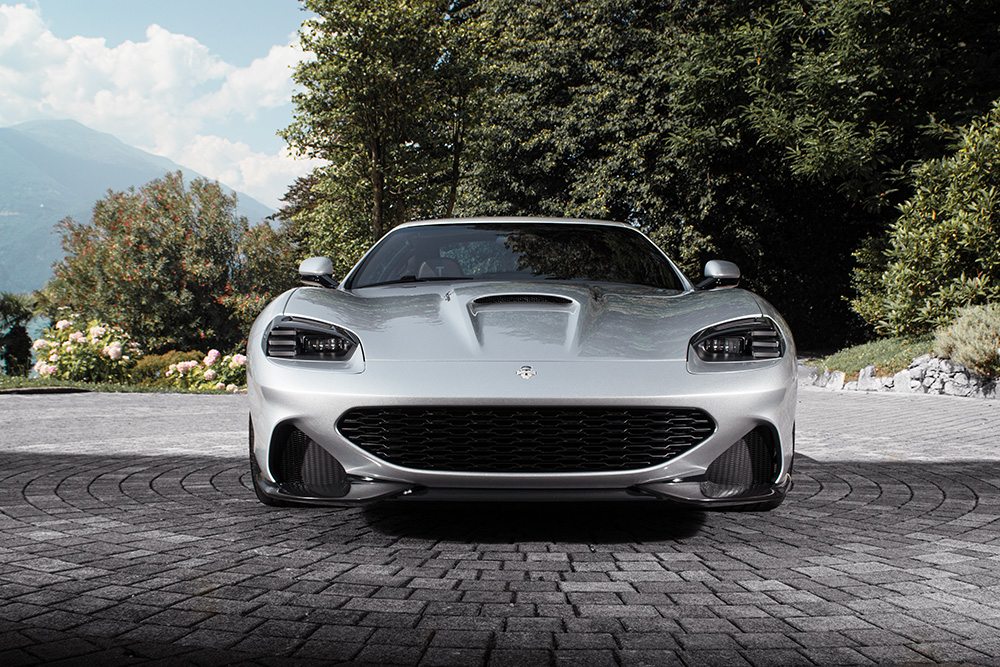
The Touring Superleggera Veloce12 is the first new car from the company’s freshly installed head of design, Matteo Gentile. We sat down with him to talk about his philosophy of design, and how that works with Touring Superleggera’s philosophy.
“To explore the intricate relationship between human perception and the design of inanimate objects such as automobiles, one must first delve into the cognitive and evolutionary underpinnings of our sensory preferences,” Matteo explains. “Throughout human history, the way we perceive and attribute characteristics to objects has been deeply influenced by the shapes and forms that we find in nature and our own physiology.”
Matteo points to the work of Yuval Noah Harari’s Sapiens as a key influence. “He frequently emphasises the importance of shared myths and collective imaginations in shaping human culture and cognition,” he says. “In this context, our preference for certain shapes over others can be seen as a shared cognitive bias that has roots in our evolutionary past. Isaac Asimov, with his profound understanding of both science and humanity, often explored how our interactions with technology and machines are influenced by these deep-seated biases.”

Matteo illustrates his view with the premise that round shapes and bulky, muscular forms are inherently perceived as more natural and comforting to humans. “This perception is not arbitrary, but rather an outcome of millions of years of evolution. Our ancestors, who roamed the savannas and forests, relied on their ability to quickly and accurately interpret their surroundings for survival. Round shapes and smooth contours are ubiquitous in nature – consider the rounded stones in a riverbed, the curves of a tree trunk, or the musculature of a predator or prey. These forms are familiar to us, embedded in our subconscious as symbols of life and vitality,” he explains.
“In contrast, sharp, edgy, and boxy forms are rare in nature. When they do appear, they often signify danger or something unnatural. The jagged edges of a cliff, the sharp thorns of a plant or the angular lines of a broken object can evoke a sense of unease or threat. As a result, humans have evolved a natural aversion to such forms. This aversion extends to our perception of man-made objects, influencing how we design and interact with technology.”
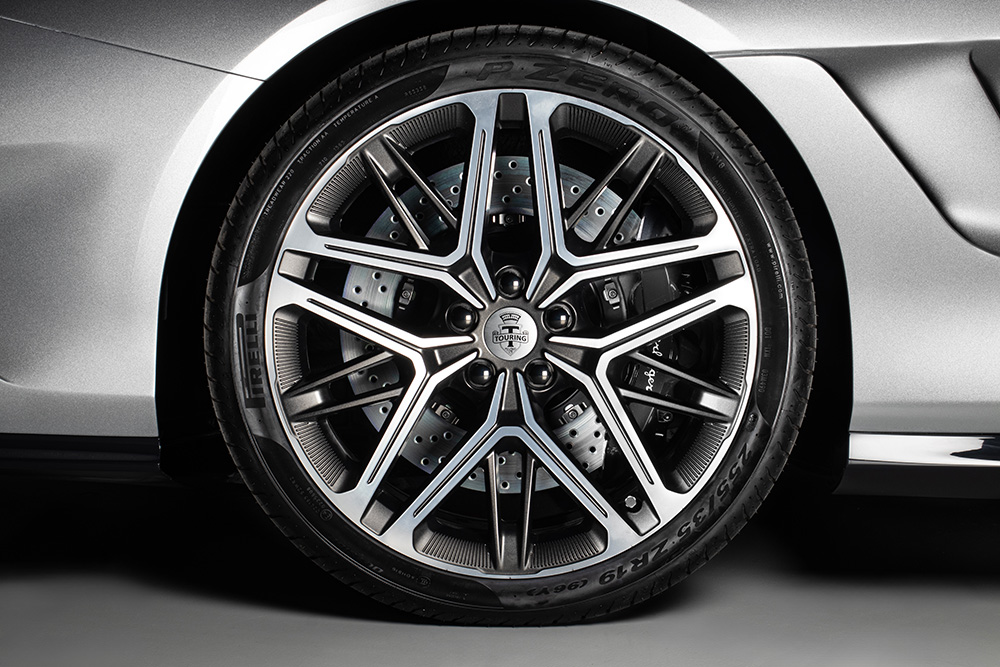
Matteo views the analogy between the car and the human body as striking and deliberate. “It’s a quintessential product of human ingenuity and a technological marvel that closely mirrors human physiology,” he says. “The analogy between a car and the human body is striking and deliberate. The car’s headlights resemble eyes, not merely because they are positioned at the front but because they convey a sense of direction and awareness. The grille, often styled to look like a mouth, suggests a capacity for breath or speech. This anthropomorphic design is not just aesthetic but functional; it helps users form a more intuitive understanding of the machine’s purpose and capabilities.”
The holistic design of a car, with its integrated systems working in harmony, also parallels the human body’s own intricate mechanisms, Matteo believes. “Just as muscles, bones and organs cooperate to sustain life, the car’s engine, transmission and suspension systems operate in concert to provide mobility. This similarity fosters a sense of familiarity and ease in users, making the technology more approachable and less alien,” he says.
“Designers, knowingly or unknowingly, capitalise on these deep-rooted cognitive biases. By emphasising roundness, bulkiness, and muscularity in their designs, they tap into the human preference for forms that evoke strength, vitality and natural order. A car with smooth curves and robust proportions is more likely to be perceived as reliable, powerful and safe. This is not merely a matter of aesthetics, but a reflection of our psychological and evolutionary predispositions.”
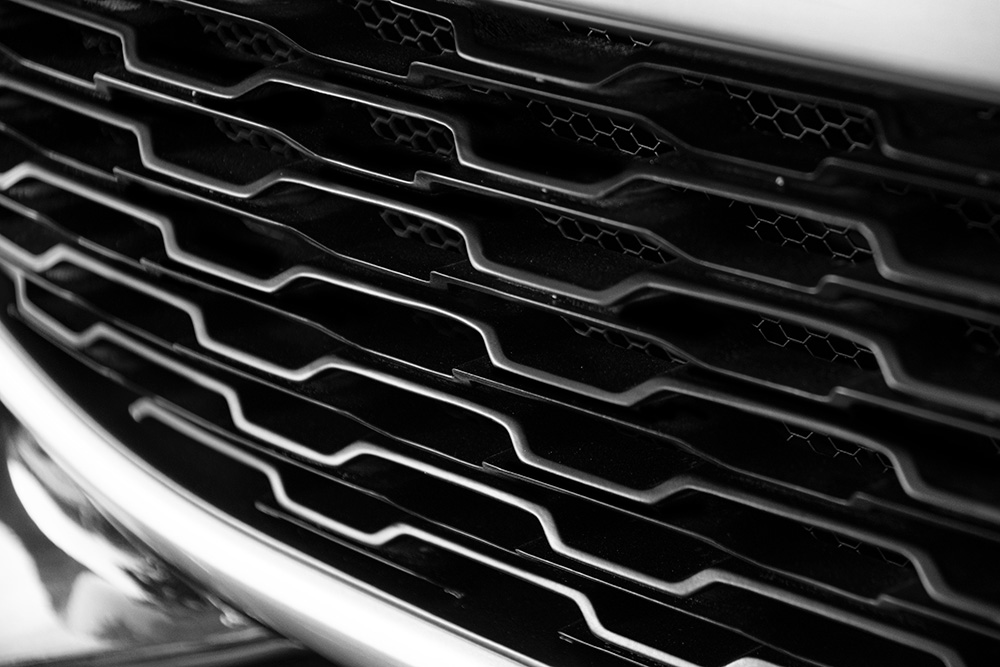
Matteo sees these principles as being even more pronounced in the realm of robotics and artificial intelligence. “As Asimov explored in his Robot series, the interaction between humans and robots is fraught with complexity and potential conflict,” he explains. “To mitigate these tensions, designers often strive to make robots appear more human-like, with rounded shapes and lifelike movements.
“This anthropomorphism is intended to foster trust and reduce the perception of robots as alien or threatening entities. However, as technology advances and our interfaces with machines become more sophisticated, there is a growing tension between functional design and psychological comfort.”
Matteo says that cutting-edge technology often necessitates the use of sharp, precise forms to convey efficiency, speed and modernity. “This creates a paradox: the very features that make a device technologically advanced can also render it psychologically alien,” he says. “To navigate this paradox, designers must strike a delicate balance. They need to create objects that are both functionally superior and psychologically palatable. This involves not just a deep understanding of engineering principles, but also an appreciation of human psychology and evolutionary biology.”
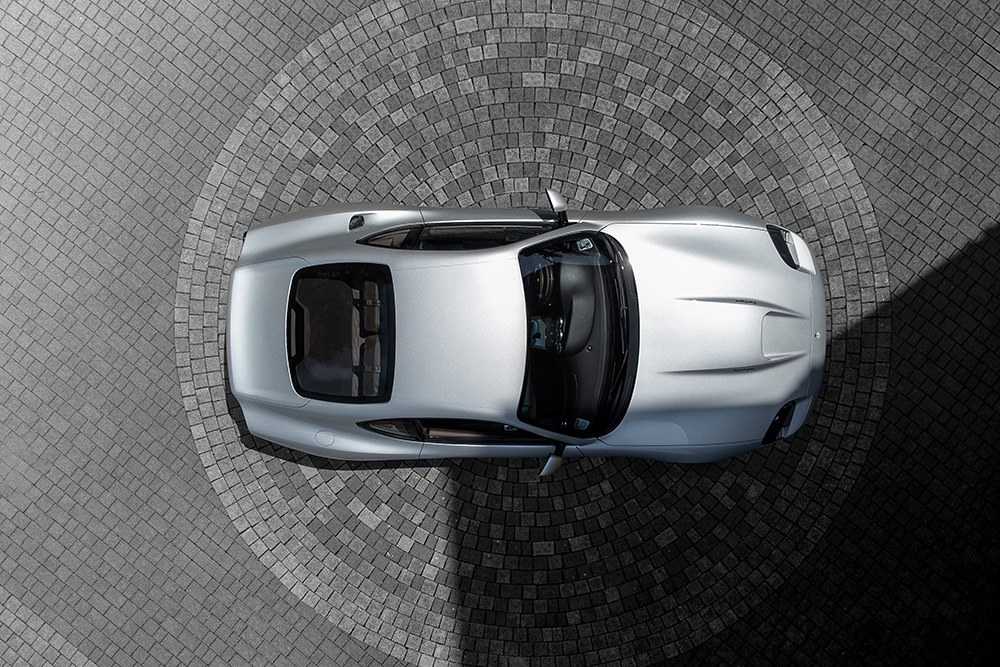
Matteo views the interplay between form and function in design as a microcosm of the broader interaction between humans and their environment. “Our preference for certain shapes is not merely a superficial aesthetic choice, but a reflection of our deepest biological and cognitive instincts,” he says. “By understanding these instincts, designers can create objects that resonate more deeply with our natural preferences, making technology more accessible and less intimidating.”
Matteo believes this nuanced understanding of design can be seen in the evolution of car aesthetics over the decades. “The sleek, curvaceous forms of the mid-20th century gave way to the more angular, aggressive designs of the late 20th century, reflecting broader cultural and technological shifts. Today, there is a resurgence of interest in more organic, human-centred design, as evidenced by the popularity of electric vehicles with their smooth, aerodynamic shapes and minimalistic interiors,” he says.
“Ultimately, the convergence of design, psychology and evolution offers profound insights into the human condition. By recognising and embracing our inherent biases, we can create a more harmonious relationship between ourselves and the technology we create. This harmony is not just about making technology more user-friendly, but about ensuring that it aligns with the fundamental aspects of what it means to be human.”
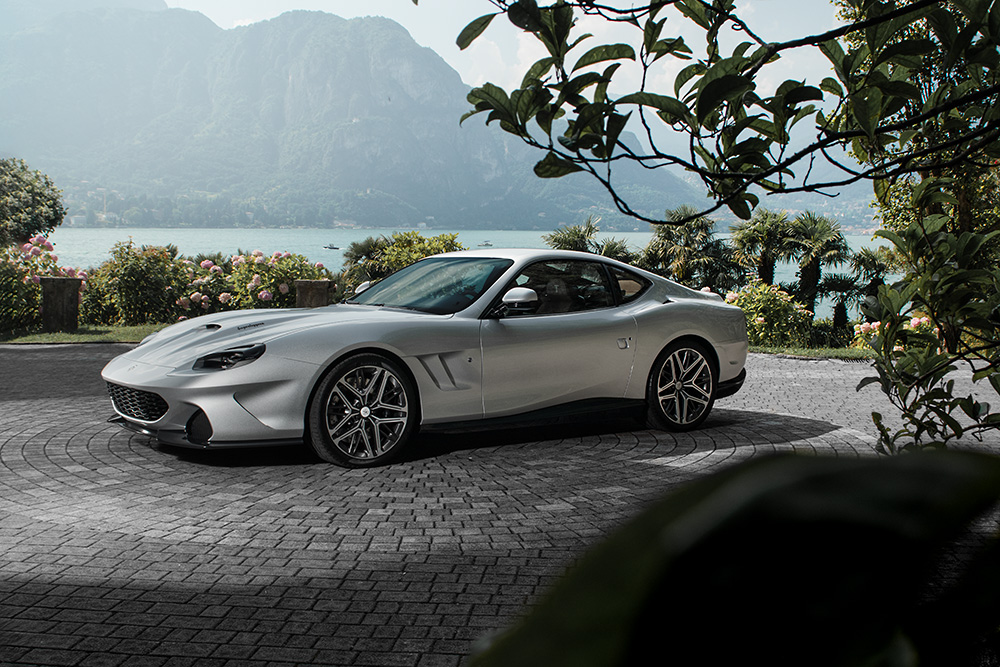
Matteo believes Touring Superleggera’s design philosophy is also characterised by a respect for the natural world. “This is evident in the organic shapes and flowing lines that define Touring’s cars, which are inspired by the elegance and efficiency of natural forms,” he says. “This biomimetic approach can be seen as a response to the human cognitive bias towards roundness and smoothness, as discussed by cognitive scientists and evolutionary biologists.
“These forms evoke a sense of familiarity and comfort, tapping into our innate preferences and enhancing the emotional connection between the car and its owner. Carrozzeria Touring Superleggera taps into this cognitive trait by crafting vehicles that are not just modes of transportation but symbols of a certain lifestyle and aspiration. Its cars are a blend of storytelling and engineering, where each model tells a tale of elegance, speed and innovation.”
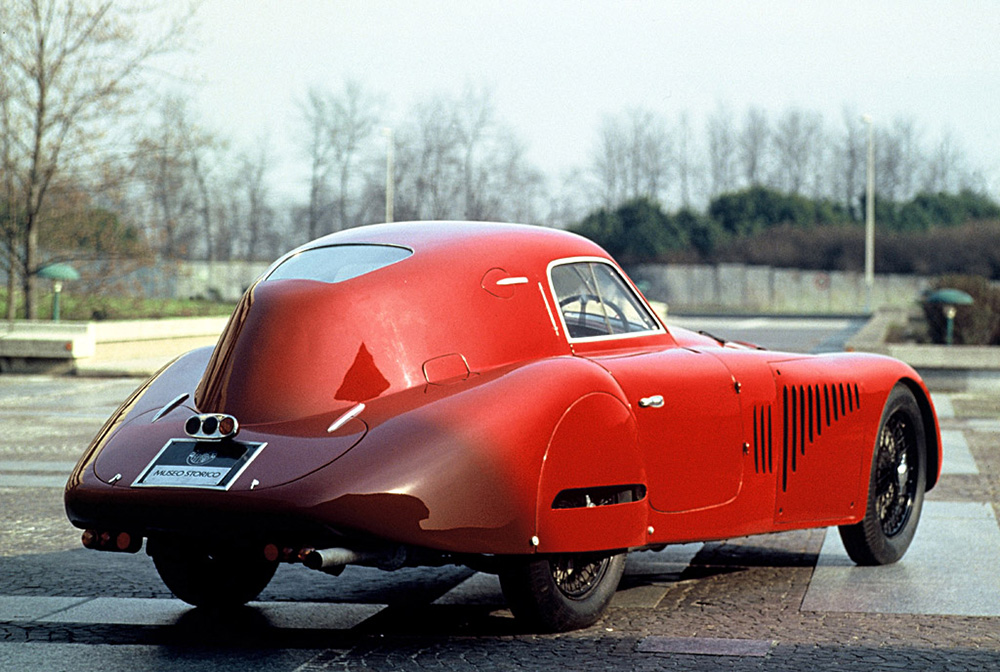
Matteo points to the Alfa Romeo 8C 2900B (above) from Touring’s oeuvre. “It is a masterpiece of the superleggera technique,” he says.”Its sleek, aerodynamic form and lightweight construction made it a formidable competitor in races, while its timeless beauty has cemented its status as a classic in automotive history.”
He also points to the Maserati 3500 GT as another highlight: “The car’s elegant lines and meticulous craftsmanship are a testament to the company’s commitment to excellence. Each curve and contour is not only aesthetically pleasing, but also serves to enhance the car’s aerodynamic efficiency and handling.”
Matteo highlights 2015’s Berlinetta Lusso as a good example of Touring pushing the boundaries of automotive design. “Its design pays homage to the company’s heritage while incorporating advanced materials and technologies,” he says. “The car’s fluid lines and lightweight construction are a perfect embodiment of the superleggera philosophy, marrying tradition with innovation in a way that feels both timeless and contemporary.”
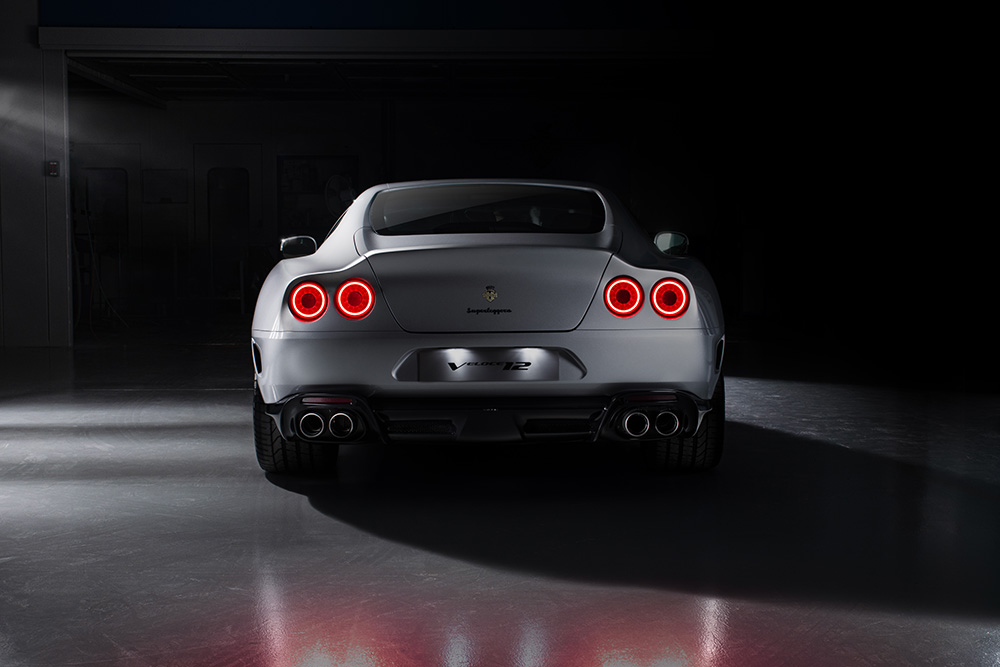
He views Touring’s philosophy of design as synthesis of art and science, tradition and innovation, human intuition and technological precision. “By adhering to the principles of superleggera, the company creates vehicles that are not only high-performance machines but also works of art that resonate deeply with human sensibilities. Their designs reflect a deep understanding of the natural world, cognitive biases and the shared myths that shape our realities,” Matteo says. “As both Harari and Asimov might agree, Touring Superleggera’s creations are a testament to the enduring power of human creativity and ingenuity, embodying the timeless quest to transcend the ordinary and achieve the extraordinary.”
With that in mind, Matteo’s inspiration for the Veloce12 stemmed from a blend of the donor car’s automotive legacy and ‘nature’s engineering’. “At the heart of our vision was a vehicle renowned for its timeless elegance and performance, a model that has set a benchmark in the industry for its seamless fusion of power and grace,” he says. “This icon of automotive design provided a foundation upon which we built, ensuring that our new creation would carry forward a legacy of excellence while introducing fresh innovations.”
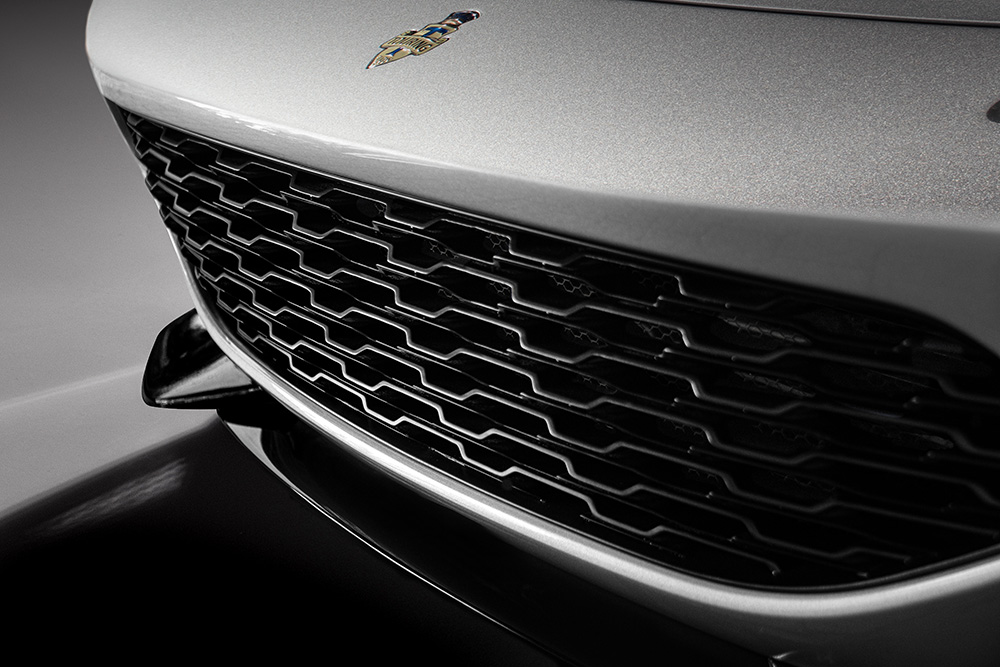
These innovations would draw inspiration from the natural world – in particular, the great white shark. “The white shark, an apex predator, embodies a perfect balance of strength, speed and streamlined efficiency,” Matteo says. “Its sleek, aerodynamic form, designed by nature to glide effortlessly through water, informed our approach to aerodynamics and aesthetics. We aimed to capture the essence of its powerful, yet graceful presence, translating its fluid lines and muscular contours into the design of the car. This dual inspiration guided us in creating a vehicle that is both an homage to a legendary automotive predecessor and a tribute to one of nature’s most efficient and formidable creatures. The result is a car that exudes both heritage and innovation, blending the best elements of human engineering and natural design.”
Although Matteo is true to type and will always want to tinker – at the car’s VIP launch, he was keen to show Magneto the latest tweaks to the design from the initial prototype – he views the side wings and the front-bumper air passage as his favourite elements. “These features not only enhance the vehicle’s aesthetic appeal, but also play crucial roles in its aerodynamic performance and overall functionality,” he says. “The side wings, inspired by the sleek and dynamic forms found in nature, add a sense of fluidity and motion to the car’s profile. They are meticulously crafted to reduce drag and improve stability at high speeds, ensuring that the car remains grounded and responsive. The way they seamlessly integrate with the car’s bodywork exemplifies the harmony between form and function, making them a standout feature in the design.”
He’s also proud of the front-bumper air passage. “This element is a perfect blend of engineering and artistry, drawing inspiration from the efficient design of the white shark. It channels air efficiently through the car’s front end, optimising cooling for the engine and enhancing aerodynamic efficiency. The design of the air passage not only serves a vital technical purpose, but also contributes to the aggressive and purposeful look of the car’s front facia,” he explains.
In the end, Matteo sees the car fitting perfectly Touring’s approach to coachbuilding. “The company’s philosophy is rooted in the Italian tradition of craftsmanship and aesthetic excellence, which can be traced back to the Renaissance, a period marked by an unparalleled fusion of art and science,” he says. “This heritage is evident in every curve, line and detail of Touring Superleggera’s creations.”
For more information on Touring Superleggera, head to www.touringsuperleggera.eu
